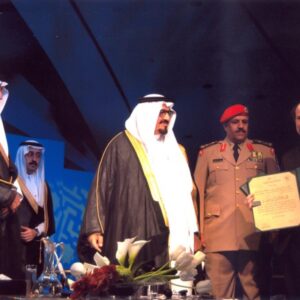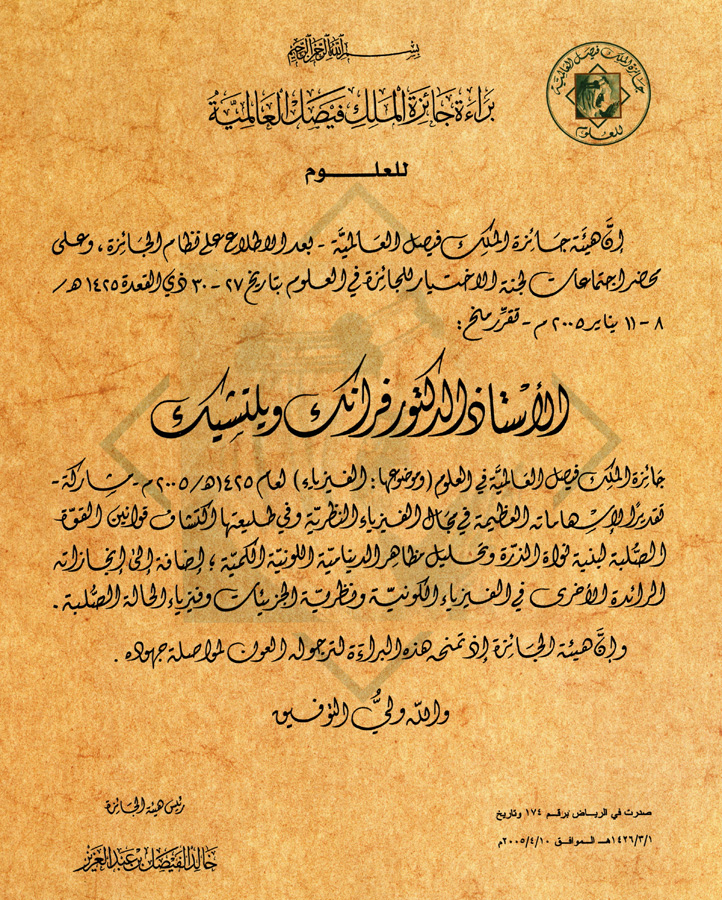

Professor Frank Wilczek
King Faisal Prize in Science 2005 Laureate
Topic: "Physics "
The community of science’s openness and honesty have allowed people to cooperate on a large scale, and for each generation to build on the achievements of those who went before

Frank Wilczek obtained his B.S. in mathematics from the University of Chicago, M.S. degree in mathematics and physics, and his Ph.D. in physics from Princeton University. He became a full Professor at Princeton at the age of 28. In 1980, he joined the University of California, Santa Barbara as a full professor, where he later became the Chancellor Robert Huttenbach Professor of Physics. In 1989, he moved to the Institute for Advanced Study at Princeton, where he became the J. Robert Oppenheimer Professor. In 2000, he was appointed as the Herman Feshbach chair of Physics at Massachusetts Institute of Technology. He is currently a Professor at MIT and also an Adjunct Professor at the Centro de Estudios Científicos of Valdivia, Chile. He was a Sloan Foundation Fellow, MacArthur Foundation Fellow, visiting professor at Harvard University and Lorentz Professor at Leiden University.
Professor Wilczek is best known for the discovery of asymptotic freedom, the development of quantum chromodynamics (QCD), the invention of axions, and the discovery and exploitation of new forms of quantum statistics (anyons). When only 21 years old and a graduate student at Princeton University working with D. Gross, he defined the properties of color gluons, which hold atomic nuclei together. This groundbreaking discovery made possible the elucidation of QCD as the correct model for the Strong Force, one of the four known forces in nature.
In addition to over 350 scientific articles and an impressive list of invited lectures, Professor Wilczek also devotes considerable effort to reflecting on the broader philosophical meaning of results in modern physics, and to communicating these results to a broader scientific audience. He contributes regularly to Physics Today and to Nature explaining topics at the frontiers of Physics. These efforts have been warmly received and have won him the Lilienfeld Prize. His popular lecture “The World’s Numerical Recipe” is globally available on the Internet, while two of his pieces were anthologized in Best American Scientific Writing (2003, 2005). Together with his wife, he wrote a beautiful book, Longing for the Harmonies.
His outstanding contributions earned him many awards and honors including the UNESCO’s Dirac Medal, the Sakurai Prize of the American Physical Society, the Michelson Prize from Case Western University and the Lorentz Medal of the Netherlands Academy. He is a member of the US National Academy of Sciences of the United States, the American Academy of Arts and Sciences, the American Philosophical Society, the American Association for the Advancement of Sciences, and the Netherlands Academy of Sciences. He is a Trustee of the University of Chicago, Editor in Chief of Annals of Physics and advisory editor or member of editorial board for several other periodicals.
This biography was written in the year the prize was awarded.
- He held several positions including:
- Visiting Professor, NORDITA in 2007.
- Visiting Professor, Oxford University in 2008.
- Distinguished Visiting Professor, Arizona State University in 2010.
- Chief Scientist, Wilczek Quantum Center in 2014.
- Founding Director of the Tsung-Dao Lee Institute in 2017.
- He received many awards and honors including:
- Golden Plate Award from the Academy of Achievement in 2005.
- Honorary Doctorate, Clark University in 2007.
- Honorary Doctorate, Maria Curie-Sklodowska University in 2008.
- Julius Wess Award in 2008.
- Casimir Funk Award in 2008.
- Oskar Klein Medal in 2013.
- Richard Prange Prize in 2016.
- Templeton Prize in 2022.


